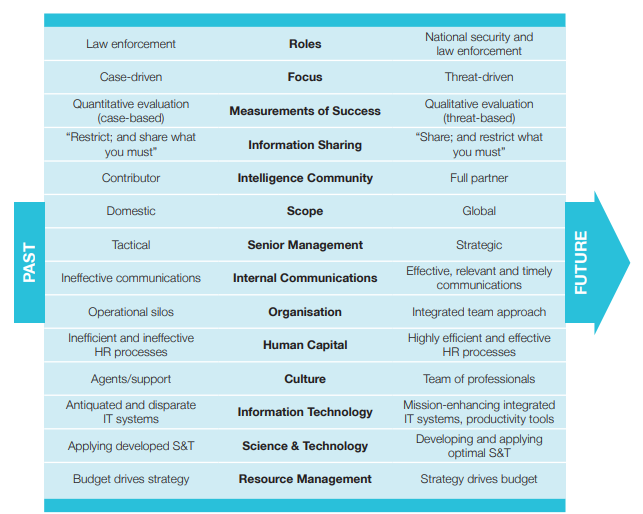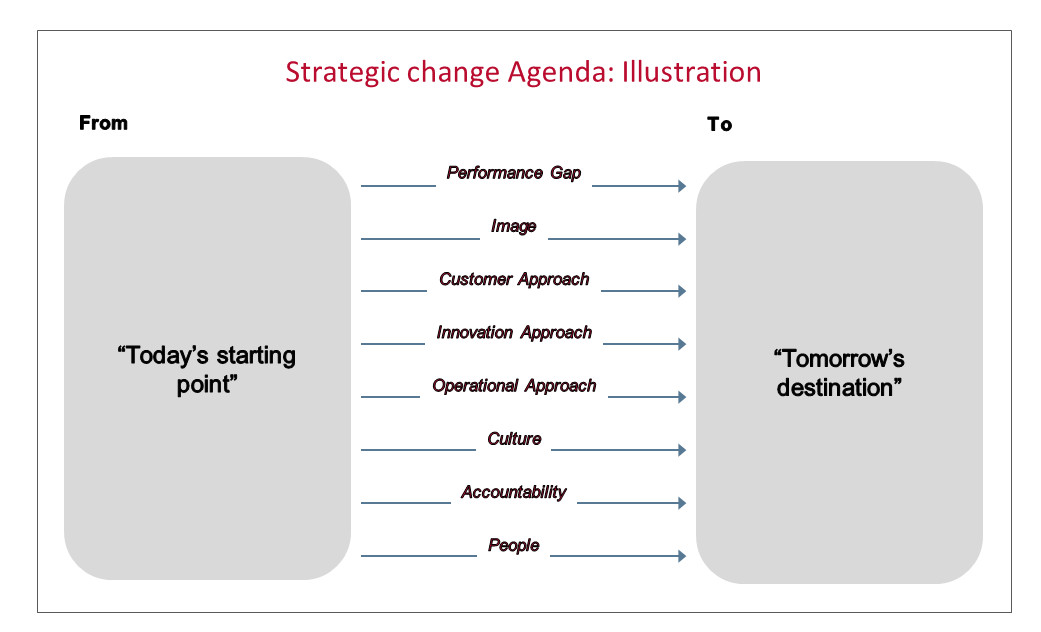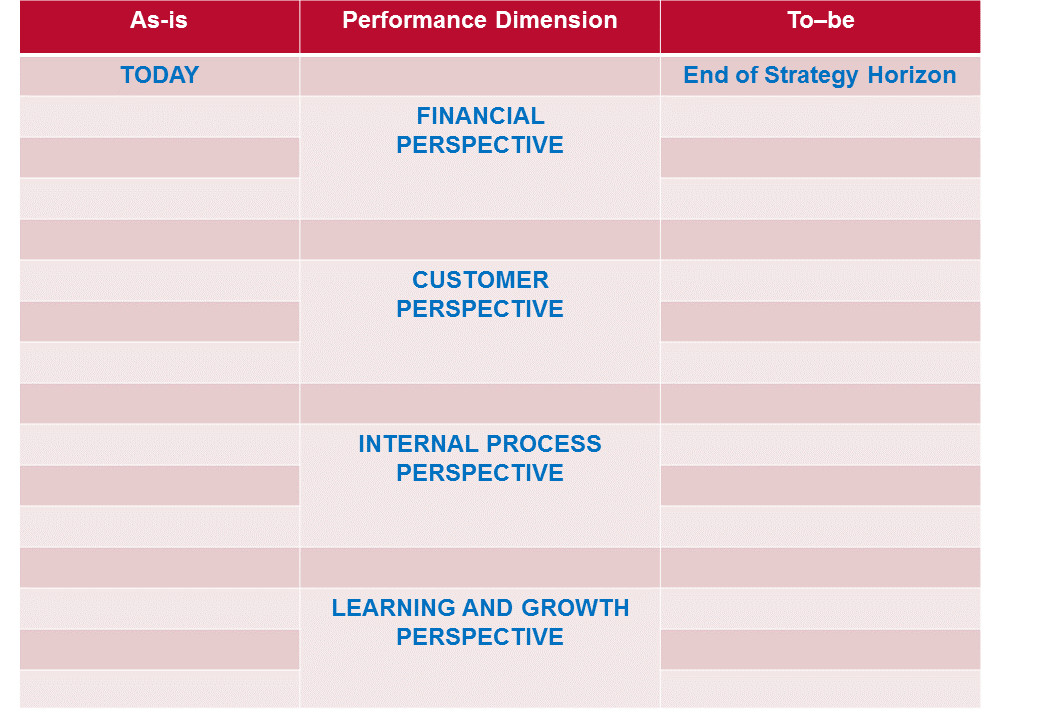Strategic change agenda
From a “process” viewpoint, the transition from strategy formulation to execution includes a sequential series of distillations: from a broad mission statement through vision and strategic choices to a specific and focused set of objectives. Many tools are available to aid this process: one that I find particularly useful is a Strategic Change Agenda.
A Strategic Change Agenda is a framework to identify and assess current state – “As is…” and to project desired future states – “To be…” for key change / performance dimensions to which an organization must pay close attention in executing its strategy. These dimensions are organization specific and must reflect the firm’s strategically critical capabilities, structure and processes. Figure 1 provides an example.
The importance of a quantified vision
To arrive at the performance dimensions, a critical input is the vision of the organization, which describes succinctly what the organization wishes to achieve over the time-frame of the strategy. To be of real value as a strategy execution aid (as opposed to little more than a promotional slogan), a vision statement should be quantified: this requires it has clear and measurable targets, be time-bound (typically the end of the strategic horizon) and provide some sense of how the organization will differentiate itself going forward.
As one example, a bank coined this vision, “We will be the benchmark in consumer banking, achieving a Top 2 ranking in our markets, with a 30% return on equity and $40 billion in total assets in the next 5 years.” As a further illustration, from the public sector (a University), “By 2015, our distinctive ability to integrate world-class research, scholarship and education will have secured us a place among the top 50 universities in the world.” In both cases, targets, time-frames and differentiation are evident. see https://www.linkedin.com/pulse/my-favorite-strategy-tools-2-quantified-vision-james-creelman
As part of a standard strategy planning process, other information will be gleaned from the external and internal scanning and other formulation/planning inputs. The organization should understand where to compete, the strength of the competition and its own strengths and weaknesses. A SWOT is often used as the final filter prior to creating the change agenda.
How can you successfully deliver on change and breakthrough performance? Discover how strategic frameworks such as Hoshin Kanri, OGSM and OKR compare and compliment one another to fuel the world’s most successful businesses. Click here to find out.
FBI case example
As a best practice illustration, the US-based Federal Bureau of Investigation (FBI) developed a Strategic Change Agenda (with facilitative support from the then Balanced Scorecard Collaborative) to reset priorities post 9/11. Figure 2.

“The change agenda (which the FBI called “Strategic Shifts”) indicates that the agency would have to undergo a major shift from being a case-driven organization (reacting to crimes already committed) to becoming a threat-driven organization (attempting to prevent a terrorist incident from occurring),” Kaplan said, adding that as a key strategic shift, agents had to make the mindset and cultural switch from being secretive to working outside of traditional operational silos and to become contributors to integrated teams. “In even more of a discontinuity, the FBI had to learn to share information and work collaboratively with other federal agencies to prevent incidents that could harm US citizens.”
The change agenda emerged from extensive dialogue throughout the organization, inviting all levels of the FBI to participate in setting the goals for the new strategic direction, which contributed to widespread understanding and support for the new strategy that followed. Kaplan explained that Director Mueller carried a laminated FBI strategic change agenda chart with him whenever he visited a field office. “If agents expressed skepticism about, or resistance to, the new initiative and structures he reminded them, using the single-page summary, why change was necessary.” (1)
With strategic change firmly in mind, why not try StratexAssess, the free strategy deployment assessment, designed to help you target areas of weakness in your strategy engine, which helps you to build upon the insights from the strategic change agenda. Click here to start your assessment.
A powerful communication tool
And this is one reason why I particularly like a Strategic Change Agenda. It is a powerful communication tool, providing rich context to why the strategy is being implemented and how far the organization is from success, thus triggering useful conversations of what needs to be done to close the gap. A Strategic Change Agenda helps the leadership articulate and communicate the cultural, structural and operating changes necessary to transition from the past to the future.
Creating the strategy map
With the performance dimensions identified, the next step is to articulate the strategic objectives. Indeed with the ultimate aim of populating a Strategy Map, some organizations arrange the change agenda according to the four perspectives of the Strategy Map. Figure 3.
FBI Case Example
Once the strategic shifts were formalized, the FBI’s senior team built a Strategy Map and supporting Balanced Scorecard of KPIs, targets and initiatives. As shown in Figure 4, key strategic themes include Management Excellence; Operational Excellence: Deter Detect, and Disrupt National Security and Criminal Threats; as well as Maximize Partnerships.
But note how the objectives (and indeed the themes) are directly linked to the strategic shifts. As examples, the shift the intelligence community signaled a transition from the “as is” (contributor) to the “to be” (full partner). This translated into the objective “enhance relationships with law enforcement and intelligence partners.” The scope shift from domestic to global was captured through “enhance international operations.” As a further example, the “as is” for information sharing was “restrict: and share what you must,” while the “to be” read “share: and restrict what you must.” This was actualized through the objective, “intelligence dissemination and integration.”
Parting words
In my work with organizations, I encourage that more time is spent on shaping the change agenda than on choosing the objectives. From my experience, if the Strategic Change Agenda is done well, the objectives just fall out.
____________________________________________________________________________________________________________
- Leading Change with the Strategy Execution System Dr. Robert S. Kaplan, Marvin Bower Professor of Leadership Development, Emeritus, Harvard Business School, Palladium, 2015.
As always feedback is welcomed.




A vision will remain just that if our actions and behaviour are not aligned with where we would like to be…..